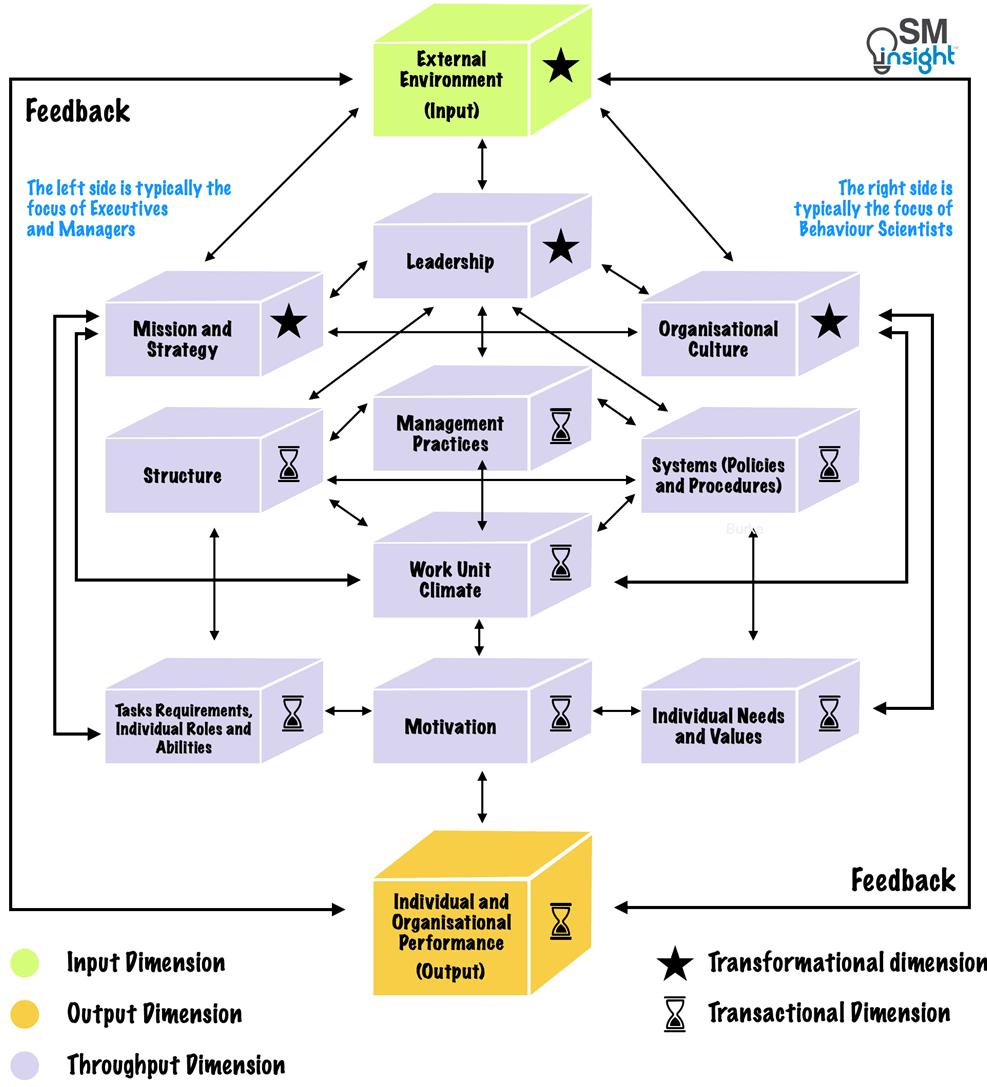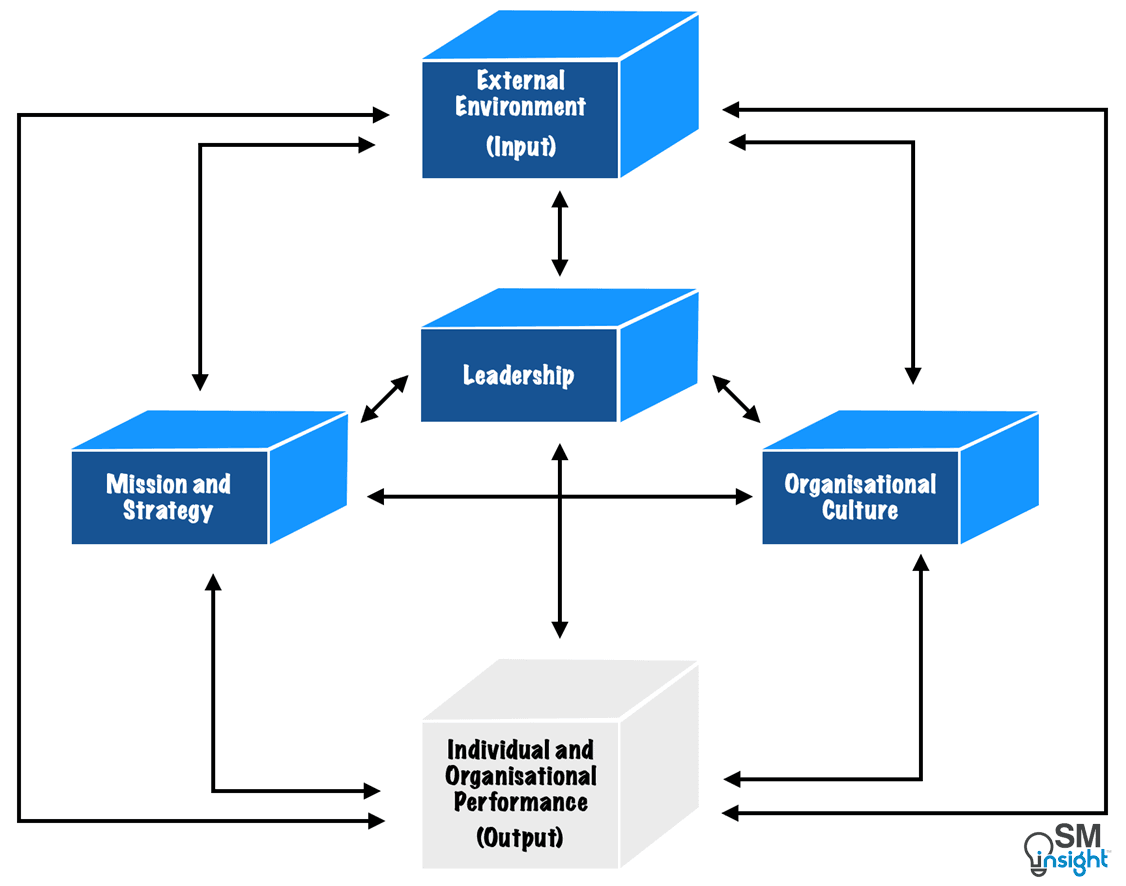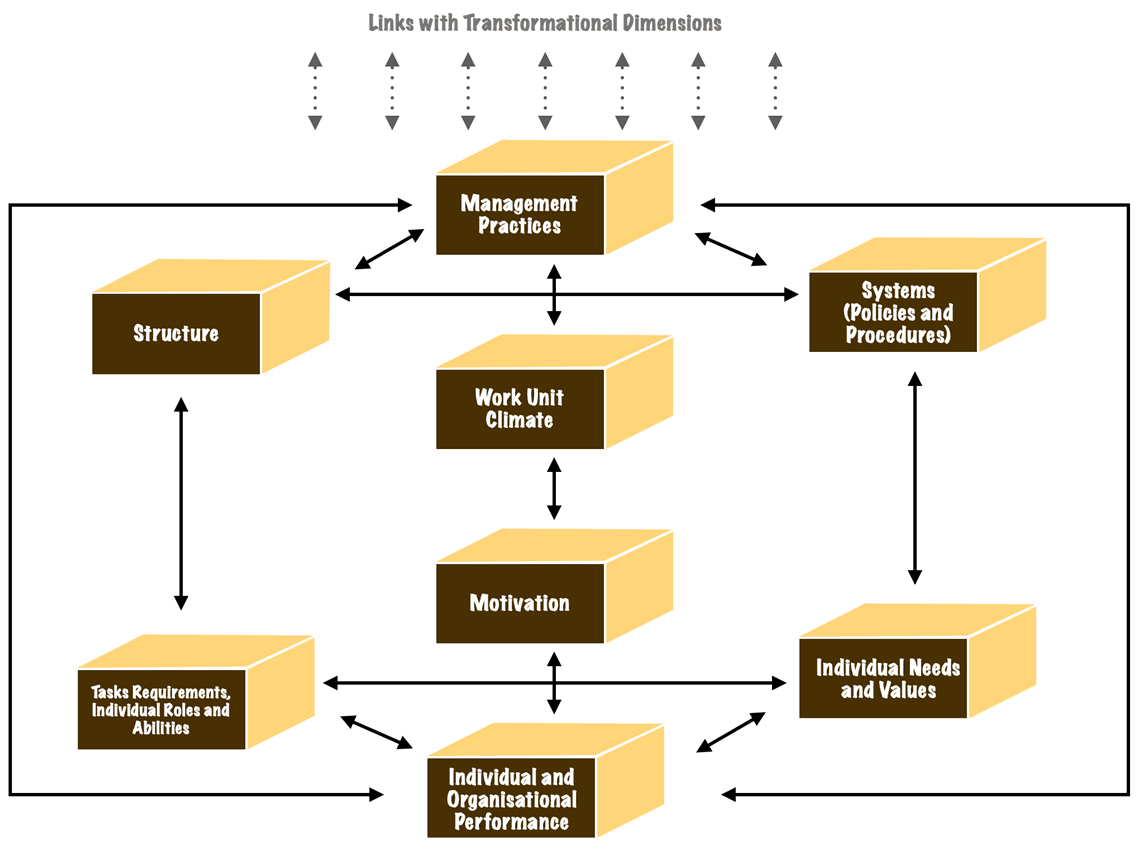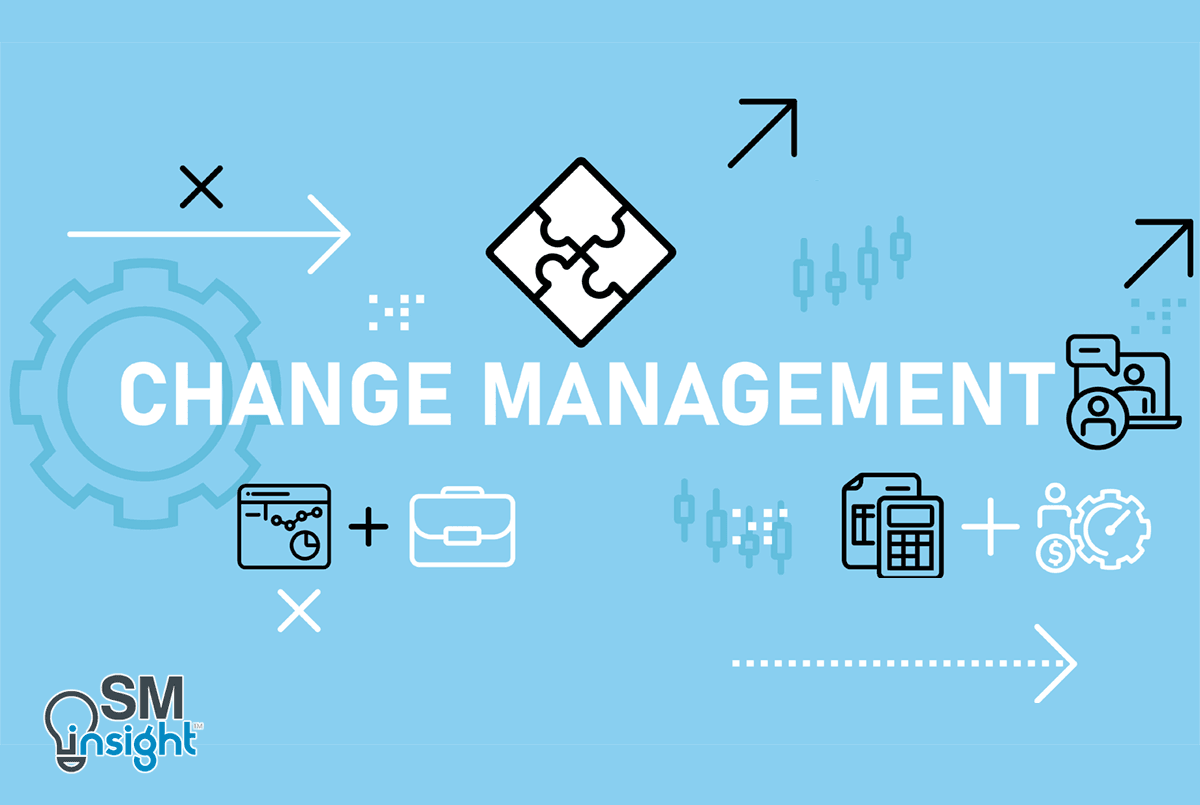Organizations must be prepared for change. They must evolve and adapt constantly to meet various challenges, from technological changes to the rise of new competitors to shifts in laws, regulations, and underlying economic trends.
While leaders work hard to implement change initiatives, it is widely observed that most change projects fail to deliver the intended outcomes. Bain research shows that only 12% of change programs succeed [1]. Because change involves so many dimensions, it is often hard to see how they interconnect and how one impacts another.
The Burke–Litwin Model of organizational performance and change helps executives visualize the interconnectedness of various organizational drivers, such as leadership, culture, and external environments, rather than adhering to a linear change process.

It helps organizational development professionals to size up the change situation, determine the kind of change (whether transformational or transactional) required, and then target interventions toward factors of the organization that will produce the desired change.
The model achieves two goals: first, as a causal model, meaning it specifies the interrelationships of organizational drivers. Second, it categorizes change drivers into transformational and transactional factors, helping executives focus on both the overarching strategic vision and everyday operational processes.
This dual focus enhances the model’s relevance across different organizational contexts, particularly as organizations must respond to external influences like market trends and technological advancements while ensuring alignment between the internal elements to drive successful change.
Background of Burke–Litwin Model
Developed by W. Warner Burke [3] and George H. Litwin, the model’s origins are rooted in the organizational climate studies Litwin and his colleagues conducted in the late 1960s. In the late 1970s and early 1980s, Burke and Litwin began collaborating in organizational change consulting, first with Citibank and later with British Airways [4]. They attempted to link sound theory and research with observations made in their consulting work.
Burke–Litwin model is based on the Open System Theory (OST) [5] and posits that organizations follow a work cycle that is shaped by inputs from the external environments, its throughput (internal systems and their actions), which leads to output, which in turn leads to a feedback loop that circles back to the external environment or the input.

While the fundamental framework for the model evolved from OST theory, the model’s components, what causes what, and in what order evolved from practice. The authors published their work in 1992 in a paper titled “A Causal Model of Organizational Performance and Change [2]”
Structure of the Model
The Burke–Litwin Model depicts twelve organizational dimensions, shown as boxes. It takes an open-systems approach, where the external environment is the input dimension and the individual and organizational performance is the output dimension.
These dimensions are connected by feedback loops, shown by bidirectional arrows indicating that the feedback goes in both directions. For example, organizational outcomes, such as products and services, can affect the external environment, such as demand and prices. Likewise, the external environment, such as government regulations, can affect the organization’s performance.
The remaining boxes represent what is known as throughput dimensions. They, too, are connected by bidirectional arrows, signifying the open-system principle of multiple effects, where a change in any one dimension or box eventually affects all the remaining dimensions.
In a real-world scenario, arrows or linkages would connect each box to all the other boxes. However, for practicality, the authors have chosen to show the most important linkages rather than attempt to show every connection.
Transformational–Transactional Distinction
The Burke–Litwin Model introduces a transformational–transactional distinction to organizational modeling. This distinction draws on leadership theory, suggesting that leaders bring about transformational changes while managers drive transactional ones. While both are equally important, the qualities required for each role differ.
Transformational leaders bring about sweeping changes, never leaving the situation as it was. This, in turn, affects the organization’s external environment – the market, community, nation, etc. – which will be different because of this kind of change.
Transactional leaders are more interested in maintaining the status quo, but if change is necessary, they would argue that it should be gradual and evolutionary, not sudden and revolutionary.
It is also interesting to note that executives and managers will typically concern themselves with the left side of the Burke–Litwin Model, while behavioral scientists are more likely to be concerned with the right side and the middle.
Transformational Dimensions
Transformational dimensions are the boxes in the top half of the Burke–Litwin Model (blue boxes in the figure below). A change in any of these will affect the entire organization or system. Such a change will be discontinuous and revolutionary and will affect the deep structure of the system, thus requiring visionary leadership.

Alterations in transformational dimensions can also be driven by environmental forces (both within and without) and will require entirely new behavior sets from organizational members.
Transactional Dimensions
Transactional dimensions are the boxes in the lower half of the model that represent factors that affect more of the organization’s day-to-day operations (transactions). Changes to these dimensions are usually described using terms such as continuous improvement, evolutionary, and selective rather than sweeping.

Changes to transactional dimensions are primarily brought about via relatively short-term reciprocity among people and groups. In other words, using a “you do this for me, and I’ll do that for you” approach.
Twelve Dimensions of the Burke–Litwin Model
External Environment
The external environment dimension represents forces or variables outside the organization that influence or will shortly influence the organizational performance. These include customer behavior and satisfaction, marketplace conditions, political circumstances, government regulations, world financial and economic conditions, and changing technology.
Mission and Strategy
The mission concerns what the organization “is all about,” its purpose, its raison d’être [7], and its primary goals. It is tied directly to the organization’s core competencies and answers the question: “If this organization did not exist, what difference would it make?”
It differs slightly from an organization’s vision, which addresses the future and concerns aspirations and desired outcomes. Though not irrational, visions are emotional and reflect the organization’s passion. Vision statements can be lofty and imply a challenge and a “stretch” for the organization over the next three to five years. Vision is, therefore, more about leadership, and mission is about purpose.
The organization’s strategy is about how its mission will be accomplished. It involves planning for what the organization must win to fulfill its mission. An organization’s strategy should flex and morph in response to future opportunities and threats. The degree to which the organization’s strategy fulfills its mission is the measure of its effectiveness.
Leadership
The Burke–Litwin Model puts leadership and management practices in separate boxes, although there is a good amount of overlap between them. Leadership is about the vision, using intuition, influence, persuasion, and presentation skills, rewarding people with personal praise, and providing opportunities to learn new skills.
Leadership is not restricted to senior executives. It can be exercised throughout the organization. The primary requirement is providing direction, whether that comes from the CEO or a front-line supervisor. Leadership also includes persuading, influencing, serving followers, and acting as a role model.
In contrast, management is about role, task accomplishments, setting objectives, using the organization’s resources (such as budget or information systems) efficiently and effectively, and rewarding people with extrinsic factors such as money, titles, and promotions.
Culture
Culture (loosely defined) is “the way we do things around here and the manner in which the norms and values are communicated.” It is the collection of overt and covert rules, values, and principles that guide organizational behavior that has been strongly influenced by the organization’s history, customs, and practice.
This includes implicit rules that are followed but never discussed, informal rules of behavior, or codes of conduct that are not written down but govern much, if not most, behavior in organizations. For example, in several companies, subordinates conform to an implicit norm by telling their boss what they believe they want to hear rather than telling the truth.
Structure
The structure is the arrangement of functions and employees in specific areas and levels of responsibility, decision-making authority, and relationships. Examples include accounting, manufacturing, human resource management, operational units of the “western region,” customer service for product group X, etc.
Structure assures the effective implementation of the organization’s mission and strategy. The structure is normally thought of as an organization chart, a diagram of boxes with titles, people’s names, and lines that connect them.
Management Practices
Management practices represent what managers do in the normal course of events and how they use human and material resources at their disposal to carry out the organization’s strategy. This includes managerial behaviors, work etiquette, professionalism, planning, communication, and control.
An example of management practice might be “encouraging direct reports and associates to take initiative with innovative approaches to various tasks and projects.” Two managers may “encourage direct reports and associates” to the same degree, but each may do it very differently. One may challenge, while the other may use highly positive remarks.
Systems
These include standardized policies and mechanisms that facilitate work. Systems primarily manifest themselves in the organization’s reward and control systems, such as goals and budgets.
Work Unit Climate
Climate represents the collective current impressions, expectations, and feelings of the employees in their respective departments. This affects their relations with their superiors, with one another, and with other departments. A positive work climate can enhance retention rates, whereas a negative one might lead to high employee turnover.
The climate in an organization is influenced by:
- How well people are managed in general.
- How clear they are about what is expected of them in the workplace.
- Do they feel their performance is recognized.
- How involved they are in decision-making.
- Do they believe they are managed according to fair standards.
- The support they feel from fellow members.
- How effectively they believe they work with other units in the organization.
Climate is much more in the foreground of organizational members’ perceptions, whereas culture is more background and defined by beliefs and values.
Task Requirements and Individual Skills/Abilities
This is essentially the degree to which the requirements of one’s job (role and responsibilities) match the individual’s knowledge, skills, and abilities. This job-person match includes recruitment, selection, appointment, and promotion elements.
The behavior, including the specific skills and knowledge required for task effectiveness, enables employees to accomplish the assigned work for which they feel directly responsible.
Individual Needs and Values
These are specific psychological factors that validate individual actions and thoughts relating to stress, well-being, recreational activities, and living conditions.
Motivation
These are aroused behavioral tendencies to move toward goals, take needed action, and persist until satisfaction is attained from the net resultant motivation, meaning the resultant net energy generated by the sum of achievement, power, affection, discovery, and other critical human motives.
Motivation results from a match between the task requirements and individual skills/abilities. It also depends on individual needs and values. For example, if there is a congruence between what an employee believes is important, worthwhile, and valuable and what the organization stands for, such as its purpose, values, and how it treats people, the employee’s motivation will increase.
Using the Burke–Litwin Model
The Burke–Litwin model, when done right, serves as an accurate picture (a representation) of an organization. Because an organization’s most accurate representation lies within the hearts and minds of its people, the model works best when developed in a way that relates to and is easily communicable to its people [5].
Hence, the best way to construct the model is by interviewing and observing people. This means conducting desk research and interviews with key stakeholders throughout the organization.
Here are a few relevant questions to ask and some tools and practices helpful in gathering data and understanding how the various dimensions interlink in an organization [8]:
| Dimension | Questions to ask | Useful tools / practices |
|---|---|---|
| External Environment | What are the key external drivers? How are they likely to impact on the organisation? Does the organisation recognize these? | PEST & PESTEL Analysis [9], Porter’s five forces model [10], SWOT Analysis [11], Competitive Intelligence [12] |
| Mission & Strategy | What do top management see as the organization’s mission and strategy? Is there a clear vision and mission statement? What are employees’ perceptions of these? | Vision and Mission Statements Review, VMOST Analysis, Balanced Scorecard [13], Focus Groups and Workshops, OKRs [14] and GAP analysis [15] |
| Leadership | Who provides overall direction for the organisation? Who are the role models? What is the style of leadership? What are the perspectives of employees? | Observation and shadowing [16], Leadership Styles Assessment, 360-Degree Feedback, Employee Surveys and Feedback |
| Organisational Culture | What are the overt and covert rules, values, customs and principles that guide organisational behaviour? | OCAI [17], Competing Values Framework [18], Employee Surveys and Feedback, Focus Groups and Workshops, Observations, |
| Structure | How are functions and people arranged in specific areas and levels of responsibility? What are the key decision-making, communication and control relationships? | Organizational Chart, RACI Matrix [19] |
| Systems | What are the organization’s policies and procedures, including systems for reward and performance appraisal, management information, HR and resource planning, etc.? | Review of performance management systems (PMS) and management Information Systems (MIS) |
| Management Practices | How do managers use human and material resources to carry out the organization’s strategy? What is their style of management and how do they relate to subordinates? | Leadership Style Assessments (E.g. Blake and Mouton Managerial Grid) |
| Work Unit Climate | What are the collective impressions, expectations and feelings of staff? What is the nature of the relationship with work unit colleagues and those in other work units? | Employee Surveys and Feedback, Observations |
| Task & Individual Skills | What are the task requirements and individual skills/abilities/knowledge needed for task effectiveness? How appropriate is the organization’s “job-person” match? | Task analysis grid, Skills matrix |
| Individual Needs & Values | What do staff value in their work? What are the psychological factors that would enrich their jobs and increase job satisfaction? | Herzberg’s two-factor theory [20], Job characteristics model, Employee value proposition, Observation and shadowing |
| Motivation | Do staff feel motivated to take the action necessary to achieve the organization’s strategy? Of factors 1-10, which seem to impact motivation the most? | Employee Surveys and Feedback, Observation and analysis |
| Individual & Organisational Performance | What is the level of performance in terms of productivity, customer satisfaction, quality, etc.? Which factors are critical for motivation and therefore performance? | KPI assessment, Performance trends, Management interviews, surveys and feedback |
The Burke–Litwin model can be developed and used as a diagnostic framework with the data gathered from the above questions. The model can be further improved by communicating results, obtaining feedback, and refining it for accuracy.
When to Use the Burke–Litwin Model
The Burke–Litwin model is among several organizational design models that serve as a basis for effective design and change management. Each has its own benefits and imitations.
The table below compares the five most commonly used models, starting with the simplest 7s model to the most complex [21] [22]:
| Model | Elements | When to use | Benefits | Limitations |
|---|---|---|---|---|
| McKinsey 7-S Model | Systems, Strategy, Structure, Style, Shared values, Staff, Skills | A multivariable framework to determine why org. are not linking capability and competence | Describes important org. elements and recognizes the interactions between them. Explains why renewal involves a complex set of processes. Can be linked to the 7-C framework of planning. | No external environment (input)/throughput/output element. No feedback loops. No performance variables. |
| Galbraith’s Star Model | Strategy, Structure, People, Rewards, Process | A review of organisation design is intended. The hierarchy seems overloaded. Extensive change is required. | Systemic. Sees an organisation as an information-processing entity | Does not include the external environment as an influencer. Does not consider key elements, including culture. |
| Weisbord Six Box Model | Leadership, Purpose, Structure, Rewards, Helpful mechanisms, Relationships | Environment is not a significant factor. Simplicity and speed of diagnosis are important. | Includes diagnostic questions in each box. Requires the purpose to be stated. Well-known, Easy to explain, Helps identify and focus priorities. | Does not show interdependencies clearly, Too simplistic, Does not examine environmental influences. |
| Nadler and Tushman Congruence Model | Informal org., Formal org., Work, People | A comprehensive analysis is required. A system perspective is required. | Easy to follow. Allows for discussion of what’s “formal” & “informal”. Suggests cause–effect relationships, highlights mismatches & congruence. Considers the influence of the external environment. | In the long, congruence can fuel resistance to change. Few named elements may lead to overlooking of crucial aspects. |
| Burke-Litwin Model | 12 dimensions as discussed earlier | A practical utility is required. To determine how organizational performance and effectiveness are affected and how change can be influenced. A cross-cultural application is required. | Explains linkages. Distinguishes between the role of transformational and transactional dynamics in org. behaviour and change. Shows cause-&-effect relationships between org’s internal and external environments. | Complicated and very detailed. Difficult to grasp at a quick glance. |
The choice of model and approach to develop the design is more a question of fit. Making the choice usually involves trade-offs and compromises and asking diagnostic questions such as the ones listed [22]:
- Does the model package the organizational elements in a way that stakeholders will recognize? Are there enough, and are they important to the organization?
- How will stakeholders react to the presented model? Is it jargon-free and simple to understand and communicate?
- Will the model find favor across the organization, or will it compete with other existing design models?
- Does the model harbor implicit assumptions that might help or hinder design work? For example, does it include or exclude factors such as local culture?
- How adaptable is the model for the specific context and circumstances in which it will be used?
- Does it enable any new perspectives or innovative thinking?
- Is it scalable from a small work unit to the whole organization?
- Does the model work with other organizational models (for example, change management or project management)?
- Are the costs of adopting the model acceptable (for example, training, communication, and obtaining buy-in)?
- Does the model allow for new and unconventional organizational design that will help drive the business strategy?
- Does the model have a sponsor or champion who will help communicate it appropriately?
- Does the model allow for transformational design as well as transactional design? (Transformational designs are developed in response to environmental forces, either internal or external, that affect the mission, strategy, and culture. Transactional changes related to the business or work-unit structures, systems, or processes that might be needed to carry out the mission and strategy but do not change them.)
It is also important to note that these organizational design and change management models were developed in an era of relative stability when organizations tended to have a single overarching business design. Today, most organizations might comprise a portfolio of companies that operate differently from one another and may have to respond more rapidly to changing business needs.
Sources
1. “It’s 8-to-1 against Your Change Program: How to Beat the Odds”. Bain & Company, https://www.bain.com/insights/its-8-to-1-against-your-change-program-how-to-beat-the-odds/. Accessed 30 Mar 2025.
2. “A Causal Model of Organizational Performance and Change”. Warner Burke and George Litwin, https://journals.sagepub.com/doi/10.1177/014920639201800306. Accessed 28 Mar 2025.
3. “Burke, W. Warner”. Teachers College, Columbia University, https://www.tc.columbia.edu/faculty/wwb3/. Accessed 30 Mar 2025.
4. “Organization Change: Theory and Practice”. W. Warner Burke, https://www.amazon.com/Organization-Change-Practice-Warner-Burke/dp/1506357997. Accessed 30 Mar 2025.
5. “The Burke-Litwin Model: A Conversation with Warner Burke”. Quality & Equality (YouTube), https://www.youtube.com/watch?v=iQ3rSph57eI. Accessed 01 Mar 2025.
6. “Open Systems Theory”. Cio-wiki, https://cio-wiki.org/wiki/Open_Systems_Theory. Accessed 01 Mar 2025.
7. “raison d’etre”. Collins, https://www.collinsdictionary.com/dictionary/english/raison-detre#. Accessed 30 Mar 2025.
8. “Promoting Institutional & Organisational Appraisal & Development”. Department for International Development, https://nsagm.weebly.com/uploads/1/2/0/3/12030125/institutional_development_sourcebook_dfid_2003.pdf. Accessed 02 Mar 2025.
9. “PEST & PESTEL Analysis”. Strategic Management Insight, https://strategicmanagementinsight.com/tools/pest-pestel-analysis/. Accessed 03 Mar 2025.
10. “Porter’s Five Forces”. Strategic Management Insight, https://strategicmanagementinsight.com/tools/porters-five-forces/. Accessed 03 Mar 2025.
11. “SWOT Analysis – How to Do It Properly”. Strategic Management Insight, https://strategicmanagementinsight.com/tools/swot-analysis-how-to-do-it/. Accessed 03 Mar 2025.
12. “Competitive Intelligence (CI) Explained”. Strategic Management Insight, https://strategicmanagementinsight.com/tools/competitive-intelligence-ci/. Accessed 03 Mar 2025.
13. “Balanced Scorecard”. Strategic Management Insight, https://strategicmanagementinsight.com/tools/balanced-scorecard/. Accessed 03 Mar 2025.
14. “Objectives and Key Results (OKR)”. Strategic Management Insight, https://strategicmanagementinsight.com/tools/objectives-key-results/. Accessed 03 Mar 2025.
15. “Gap Analysis”. Strategic Management Insight, https://strategicmanagementinsight.com/tools/gap-analysis/. Accessed 03 Mar 2025.
16. “Observation and Shadowing: Two Methods to Research Values and Values Work in Organisations and Leadership”. Stephen Sirris, Tone Lindheim and Harald Askeland, https://www.researchgate.net/publication/358626523_Observation_and_Shadowing_Two_Methods_to_Research_Values_and_Values_Work_in_Organisations_and_Leadership. Accessed 03 Mar 2025.
17. “About the Organizational Culture Assessment Instrument (OCAI)”. OCAI online, https://www.ocai-online.com/about-the-Organizational-Culture-Assessment-Instrument-OCAI. Accessed 02 Mar 2025.
18. “An Introduction to the Competing Values Framework”. Kim Cameron, PhD, https://www.thercfgroup.com/files/resources/an_introduction_to_the_competing_values_framework.pdf. Accessed 03 Mar 2025.
19. “Responsibility assignment matrix”. Wikipedia, https://en.wikipedia.org/wiki/Responsibility_assignment_matrix. Accessed 03 Mar 2025.
20. “Herzberg’s Two-Factor Theory Of Motivation-Hygiene”. Simply Psychology, https://www.simplypsychology.org/herzbergs-two-factor-theory.html. Accessed 03 Mar 2025.
21. “Applying the Burke–Litwin model as a diagnostic framework for assessing organisational effectiveness”. N. Martins and Melinde Coetzee, https://www.researchgate.net/publication/47727892_Applying_the_Burke-Litwin_model_as_a_diagnostic_framework_for_assessing_organisational_effectiveness. Accessed 03 Mar 2025.
22. “Guide to Organisation Design (Economist Books)”. Naomi Stanford, https://www.amazon.com/Guide-Organisation-Design-high-performing-enterprises/dp/1610395395/. Accessed 03 Mar 2025.
23. “McKinsey 7S Model”. Strategic Management Insight, https://strategicmanagementinsight.com/tools/mckinsey-7s-model-framework/. Accessed 03 Mar 2025.
24. “Star Model”. Jay Galbraith, https://jaygalbraith.com/services/star-model/. Accessed 03 Mar 2025.
25. “Weisbord’s Six-Box Model”. CIO Wiki, https://cio-wiki.org/wiki/Weisbord%E2%80%99s_Six-Box_Model. Accessed 03 Mar 2025.
26. “Congruence Model”. CIO Wiki, https://cio-wiki.org/wiki/Congruence_Model. Accessed 03 Mar 2025.

